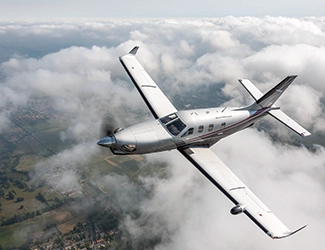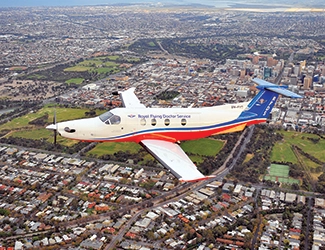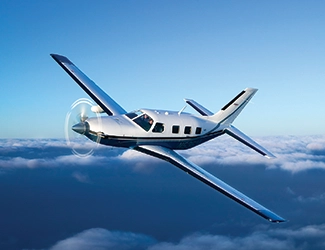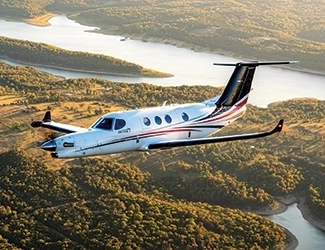Turboprop operations
TPs are ideal for the short-hop corporate and private aviation market.
By Shannon Forrest
ATP/CFII. Challenger 604, G-IV
Contributing Writer
It’s easy to become enamored of jets. They’re fast, they fly high, and, whether it’s a military fighter (which naval aviators often refer to simply as “the jet”) or a sleek, high-tech business jet fresh off the production line, being powered by a turbojet engine is impressive – so much so that newly-minted pilots aspiring to a career in aviation often set their sights on transitioning directly from piston engines to jet-powered aircraft.
Given the massive hiring surge in aviation over the past decade – largely driven by major airlines replacing retirees and expanding – this is a likely outcome for those holding a new commercial or ATP license. Today, just 25 hours in a Piper Seneca or Seminole may be enough to secure the right seat of a turbojet-powered Canadair or Embraer regional jet. But that wasn’t always the case.
The turboprop’s role in aviation
Historically, the venerable turboprop filled the career gap between flying piston-engine aircraft and transitioning to jets. Throughout the 1990s and into the 2000s, virtually every regional airline (then called commuter airlines) operated turboprops, or a mix of turboprops and jets.
Companies like Comair, Atlantic Coast Airlines, Mesaba, Atlantic Southeast Airlines, and American Eagle (now Envoy) were a constant presence in the skies with turboprop aircraft like Embraer Brasilias, BAe Jetstreams, ATR 42s, and Saab 340s.
Landing an interview often meant accumulating hours through multi-engine instruction or flying the grueling middle-of-the-night shifts in a Piper Navajo or Beech Baron.
Outside the airlines, turboprops dominated the freight world, where their ability to be flown by a single pilot offered significant operational cost savings. Aircraft like the Cessna 208 Caravan became a staple for overnight delivery companies, and the Fairchild Metroliner was frequently used in freight operations, particularly in the automotive industry.
The Mitsubishi MU-2, with its rugged reputation, was favored by the Federal Reserve for hauling checks on midnight runs, typically covering medium-length 60- to 90-minute routes.
Development and initial rise
To understand where turboprops fit in aviation today, it’s important to look at their origins. After World War II, air travel demand skyrocketed, and manufacturers sought ways to produce aircraft that could fly higher and faster than traditional piston-powered planes.
In 1948, Rolls-Royce installed the first turboprop engine on an aircraft, although early engineering dates back as far as 1929. The British Vickers Viscount, powered by Rolls-Royce Dart turboprops, first flew in 1948 and entered service in 1953, becoming the first commercial airliner to use turboprop engines. In the US, the Lockheed L-188 Electra, which entered service in the late 1950s, became the first US commercial turboprop airliner.
However, the 1960s marked the dawn of the jet age, and the turboprop quickly fell out of favor for long-haul air travel. Ironically, while airlines moved away from turboprops, Beechcraft capitalized on their strengths – efficiency at lower altitudes and speeds below 400 kts, plus the fact that turboprops require shorter runways than jets. Beech’s first turboprop, the King Air 90, could carry 6–8 passengers and cruise at 270 kts. By 1966, Beech had delivered 100 King Airs.
Today, turboprops have largely fallen out of favor with US airlines. In the past, the relatively short routes and low altitudes made turboprops ideal for regional operations. However, regional airlines – once wholly owned by their parent legacy carriers or operating as feeders – now fly routinely longer distances of more than 1500 miles, a range that is simply not economically viable for transport-category turboprops.
Even the classic “turboprop legs” of less than 45 minutes flying time have been replaced by jets. Silver Airways, one of the last remaining all-turboprop operators in the US (flying ATR 42s and 72s), recently filed for Chapter 11 bankruptcy protection.
Turboprops in the private and corporate markets
Despite the decline in regional airline operations, turboprop demand among private, corporate, and charter operators is booming. The turboprop is still seen as a “step up” from piston engines, making it a popular choice for owner/operators transitioning from high-performance singles or light to medium twin-engine piston aircraft. At this level, many operators also serve as their own pilots, often flying single-pilot operations.

Interestingly, pilots tend to exhibit an compelling psychological shift when it comes to single-engine operations. Many are reluctant to fly a single-piston engine aircraft over water, in mountainous terrain at night, or in marginal weather conditions.
Despite this, the same pilots may feel comfortable flying a turboprop in these challenging situations. The key factor? The Pratt & Whitney PT6 engine. Widely regarded as bulletproof, the PT6 instills confidence in pilots who might otherwise be cautious about flying a piston single in difficult conditions.
Daher
The fast and efficient TBM 960 is another standout, featuring the PT6E-66XT engine, which offers a cruise speed of 330 kts, with a more fuel-efficient setting yielding 308 kts at 57 gallons per hour.
The aircraft is equipped with a 5-blade composite Hartzell Raptor propeller, improving both performance and comfort. The TBM 960’s Garmin G3000 avionics package includes an emergency HomeSafe function, which brings the aircraft to a safe landing without pilot intervention.
The Kodiak family adds versatility and short-takeoff-and-landing (STOL) performance to Daher’s lineup. The single-engine turboprops are designed for STOL operations. Powered by a PT6-140A engine, the Kodiak is capable of carrying up to 10 passengers and is ideal for operations in remote areas. Its rugged design makes it popular with forestry operations and backwoods flying in places like Alaska.

Pilatus
The PC-12 is the benchmark for commercial-caliber single-engine turboprops. Known for its versatility, the PC-12 features an executive interior designed in collaboration with BMW, capable of seating up to 10 passengers in comfort.
The aircraft’s large cargo space and the ability to operate from short, unimproved airstrips have made it a favorite for various mission types, including air ambulance and surveillance.
The US Air Force even modified some PC-12s for special operations, rebranding them as the U-28A Draco.
Piper
The M500 is a single-engine powerhouse. Consider the 1984 Piper Malibu – a piston-powered aircraft that, after significant upgrades, became the Piper M500 – a single-engine turboprop.

The M500 is equipped with the PT6A-42A engine, flat-rated at 500 shp, and boasts impressive performance, including a fuel consumption of just 35 gallons per hour at cruise, a 2400-ft takeoff distance over a 50-ft obstacle, and a maximum cruising speed of 260 kts at FL300.
With a wingspan of 43.0 ft and a height of 11.3 ft, the M500 offers flexibility in hangar options. Its Garmin G1000NXi avionics suite includes the GFC 700 autopilot, and incorporates safety features like automated stability control and envelope protection.
Textron Aviation
Larger than the M500, the advanced Beechcraft Denali is another contender in the small to medium single-engine turboprop category, offering impressive size and performance. With a takeoff distance of 2950 ft, it promises a 1600-nm range at FL310 with 4 passengers.
The Denali is notable for its advanced Garmin G3000 avionics and the use of the GE Catalyst engine – the first clean-sheet turboprop engine in over 50 years.
The Catalyst engine features 3-D printed components, making it lighter and more durable, and integrates propulsion control into a single lever, eliminating the need for the traditional condition lever.

The Beechcraft King Air family represents the legacy of turboprop excellence, and is by far the most ubiquitous turboprop aircraft in the corporate world. Despite its relatively simple exterior, the King Air has been a mainstay for 60-plus years, with pilots and passengers alike continuing to favor its stability, ease of handling, and solid safety record.
Beechcraft’s attempts to replace the King Air with more futuristic designs, like the all-composite Starship, failed. Still, the King Air remains the most successful twin-engine turboprop on the market, and its strong aftermarket support – from avionics upgrades to high-performance engines – keeps it relevant.
The turboprop experience
While turboprops may not receive as much attention as jets, they offer a wealth of experience for pilots. Many hiring managers value candidates with significant turboprop time, particularly if they have experience flying in challenging weather conditions.
As more pilots transition directly from piston engines to jets, the turboprop fraternity is shrinking. Nonetheless, those who have spent time in turboprops likely have fond (and occasionally frustrating) memories that contributed to their growth as aviators and helped them get to where they are today.
 Shannon Forrest is a current line pilot, CRM facilitator, and aviation safety consultant. He has more than 15,000 hrs TT and holds a degree in behavioral psychology.
Shannon Forrest is a current line pilot, CRM facilitator, and aviation safety consultant. He has more than 15,000 hrs TT and holds a degree in behavioral psychology.